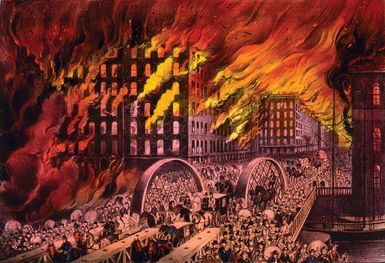Historical development of insurance
Insurance in some form is as old as historical society. So-called bottomry contracts were known to merchants of Babylon as early as 4000–3000 bce. Bottomry was also practiced by the Hindus in 600 bce and was well understood in ancient Greece as early as the 4th century bce. Under a bottomry contract, loans were granted to merchants with the provision that if the shipment was lost at sea the loan did not have to be repaid. The interest on the loan covered the insurance risk. Ancient Roman law recognized the bottomry contract in which an article of agreement was drawn up and funds were deposited with a money changer. Marine insurance became highly developed in the 15th century.
In Rome there were also burial societies that paid funeral costs of their members out of monthly dues.
The insurance contract also developed early. It was known in ancient Greece and among other maritime nations in commercial contact with Greece.
England
Fire insurance arose much later, obtaining impetus from the Great Fire of London in 1666. A number of insurance companies were started in England after 1711, during the so-called bubble era. Many of them were fraudulent, get-rich-quick schemes concerned mainly with selling their securities to the public. Nevertheless, two important and successful English insurance companies were formed during this period—the London Assurance Corporation and the Royal Exchange Assurance Corporation. Their operation marked the beginning of modern property and liability insurance.
No discussion of the early development of insurance in Europe would be complete without reference to Lloyd’s of London, the international insurance market. It began in the 17th century as a coffeehouse patronized by merchants, bankers, and insurance underwriters, gradually becoming recognized as the most likely place to find underwriters for marine insurance. Edward Lloyd supplied his customers with shipping information gathered from the docks and other sources; this eventually grew into the publication Lloyd’s List, still in existence. Lloyd’s was reorganized in 1769 as a formal group of underwriters accepting marine risks. (The word underwriter is said to have derived from the practice of having each risk taker write his name under the total amount of risk that he was willing to accept at a specified premium.) With the growth of British sea power, Lloyd’s became the dominant insurer of marine risks, to which were later added fire and other property risks. Today Lloyd’s is a major reinsurer as well as primary insurer, but it does not itself transact insurance business; this is done by the member underwriters, who accept insurance on their own account and bear the full risk in competition with each other.

United States
The first American insurance company was organized by Benjamin Franklin in 1752 as the Philadelphia Contributionship. The first life insurance company in the American colonies was the Presbyterian Ministers’ Fund, organized in 1759. By 1820 there were 17 stock life insurance companies in the state of New York alone. Many of the early property insurance companies failed from speculative investments, poor management, and inadequate distribution systems. Others failed after the Great Chicago Fire in 1871 and the San Francisco earthquake and fire of 1906. There was little effective regulation, and rate making was difficult in the absence of cooperative development of sound statistics. Many problems also beset the life insurance business. In the era following the U.S. Civil War, bad practices developed: dividends were declared that had not been earned, reserves were inadequate, advertising claims were exaggerated, and office buildings were erected that sometimes cost more than the total assets of the companies. Thirty-three life insurance companies failed between 1870 and 1872, and another 48 between 1873 and 1877.

After 1910 life insurance enjoyed a steady growth in the United States. The annual growth rate of insurance in force over the period 1910–90 was approximately 8.4 percent—amounting to a 626-fold increase for the 80-year period. Property-liability insurance had a somewhat smaller increase. By 1989 some 3,800 property-liability and 2,270 life insurance companies were in business, employing nearly two million workers. In 1987 U.S. insurers wrote about 37 percent of all premiums collected worldwide.
Russia
Insurance in Russia was nationalized after the Russian Revolution of 1917. Domestic insurance in the Soviet Union was offered by a single agency, Gosstrakh, and insurance on foreign risks by a companion company, Ingosstrakh. Ingosstrakh continues to insure foreign-owned property in Russia and Russian-owned property abroad. It accepts reinsurance from foreign insurers. However, following the movement toward a free market economy (perestroika) after 1985 and the breakup of the Soviet Union in 1991, some 230 new private insurers were established.
Gosstrakh offers both property and personal insurance. The former coverage is mandatory for government-owned property and for certain property of collective farms. Voluntary property insurance is available for privately owned property. Personal coverages such as life and accident insurance and annuities also are sold.
Before 1991, insurance against tort liability was not permitted, on the ground that such coverage would allow negligent persons to escape from the financial consequences of their behaviour. However, with the advent of a free market system, it seems likely that liability insurance will become available in Russia.
Eastern Europe
After the breakup of the Soviet Union, countries in eastern Europe developed insurance systems of considerable variety, ranging from highly centralized and state-controlled systems to Western-style ones. Because of recent political and economic upheavals in these countries, it seems likely that the trend will be toward decentralized, Western-style systems.
A few generalizations about insurance in eastern European countries may be made. Although state insurance monopolies are common, they are losing some business to private insurers. Insurance of state-owned property, which was considered unnecessary in socialist states, has been established in several countries.



